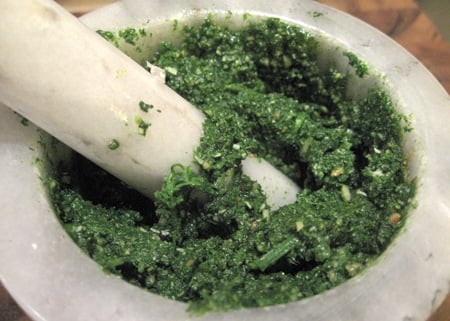
Pesto can be made from really anything — you don’t even need a green thing. I’ve seen pestos with basil of course, but also mint, parsley, cilantro and other herbs. No reason not to make it with stinging nettles. The Italians actually do make a nettle pesto in springtime; they call it pesto d’urtica.
You must first blanch the nettles before making this pesto. This is how:
- You will need two or three big tong-fulls of fresh nettles for this recipe. I say tong-fulls because you do not want to pick up fresh nettles, as they will sting you. Thus the name. Get a huge pot of water boiling and add a handful of salt.
- Grab the nettles with tongs and put them into the boiling water. Stir around and boil for 1-2 minutes.
- Fish them out with a skimmer or the tongs and immediately dump them into a big bowl with ice water in it. Once they are cool, put them in a colander to strain.
- Get a cloth towel, like a tea towel, and put the nettles in it. Wrap one end of the towel one way, then the other end of the towel the other and squeeze out as much moisture as you can.
This makes a little more than 1/2 cup of very green, very pretty pesto. Store any unused pesto in the fridge, topped with some olive oil to keep the air out.
- 3 garlic cloves
- 2 tablespoons toasted pine nuts
- 2 tablespoons grated cheese (any hard cheese will do)
- 1/2 to 2/3 cup blanched, chopped nettles
- Salt
- Olive oil (use the good stuff)
- Pesto is best made with a mortar and pestle, thus the name, which means “pound.’ You can make this in a food processor, but it will not be the same. First add the pine nuts and crush lightly — as they are roundish, they will jump out of your mortar if you get too vigorous.
- Roughly chop the garlic and add it to the mortar, then pound a little.
- Add the salt, cheese and the nettles and commence pounding. Mash everything together, stirring with the pestle and mashing well so it is all fairly uniform.
- Start adding olive oil. How much? Depends on how you are using your pesto. If you are making a spread, maybe 2 tablespoons. If a pasta sauce, double that or more. Either way, you add 1 tablespoon at a time, pounding and stirring to incorporate it.
- Serve as a spread on bread, as an additive to a minestrone (like this one), as a pasta sauce or as a dollop on fish or poultry.
MORE NETTLE RECIPES:
- Strettine, a nettle pasta
- Risotto with Nettles
- Nettle Ravioli, Northern Italian style